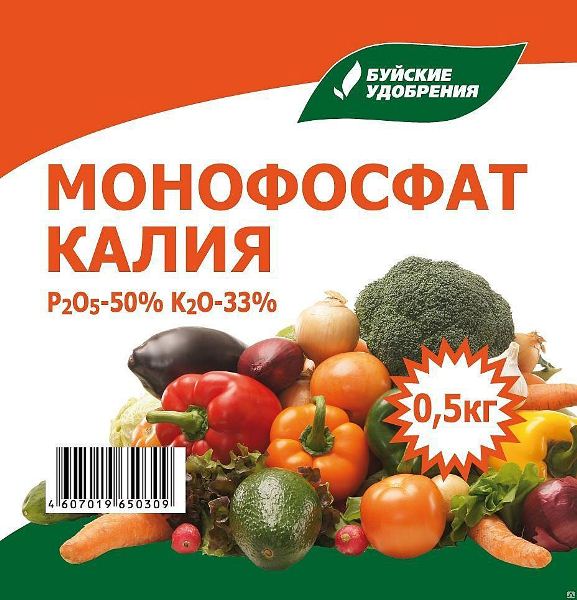To increase the yield of each gardener uses fertilizer. They fill the soil with beneficial elements and nourish the plants. Such properties possesses potassium monophosphate. The instructions for the use of this drug can be found below.
Table of contents
The composition and purpose of potassium monophosphate
It is a concentrated white powder. It is easily dissolved in water and quickly absorbed by the soil. It consists of potassium (33%) and phosphorus (50-55%). Refers to mineral fertilizers.
These two elements contribute to a multiple increase in the yield of vegetables, fruits and berries, increase the content of vitamins. Increases the shelf life of the crop. After its application, garden crops tolerate disease better.

This fertilizer is produced in two types:
- Powder. It can only be dissolved in water, which should not be increased rigidity, because it tends to sinter.
- Granules. They can both be dissolved and shut off with water of any quality.
Mechanism of action
As soon as the fertilizer is dissolved in water, the main quantity of orthophosphoric acid actively begins to be delivered to the plants, bypassing the chemical reactions in the soil.
Potassium interacts with the soil and is then absorbed by the cultures. It has no property to accumulate in the ground. Best kept on loamy and clay types of soil.
Advantages and disadvantages compared with other means
All fertilizers have their positive and negative sides. It is important to know how they differ from other mineral supplements. Benefits:
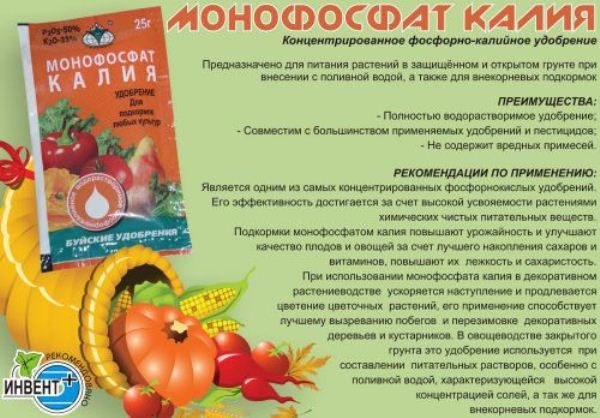
- Quickly absorbed into the soil, immediately begins to feed the plants.
- There are no harmful substances.
- Is capable of protect from cold in the period of frost.
- Effectively moisturizes dried soil.
- Perfect for everyone indoor plants.
- Helps young cultures to raise number of shoots.
- Compatible with pesticides.
- Does not oxidize the soil.
- Prevents plants from disease powdery mildew.
We should not ignore the disadvantages of potassium monophosphate:
- In the soil is not able to accumulate, breaks fast.
- For the preparation of crops for the winter is not used, since not stored in the ground.
- Weeds also prefer to eat this feeding.
- Not compatible with fertilizers.that contain calcium and magnesium.
- For indoor plants, which develop slowly (orchids, azaleas, gloxinia and others) is not suitable, since it has a high activity.
Fertilizer application instructions
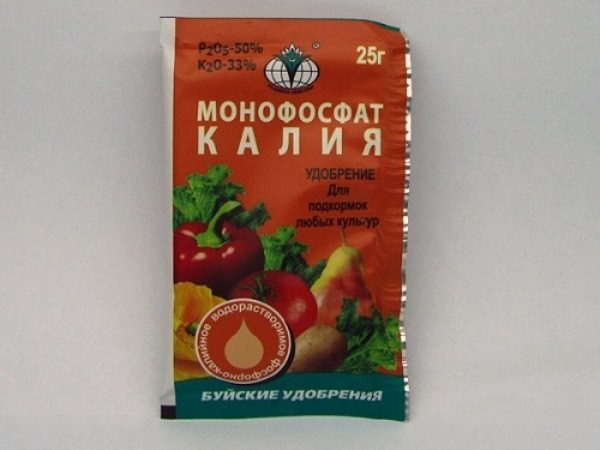
First you need to carefully study the rules for the use of fertilizers, which are printed on the package.
Potassium monophosphate is used in the following cases:
- for seedlings of garden crops in those years when the landing time is not delayed;
- for better flowering and fruiting horticultural crops;
- for abundant flowering ornamental plants;
- for quick foliar dressing garden and indoor plantsif there is a lack of potassium (the leaves become brown, shriveled).
Preparation of working solution
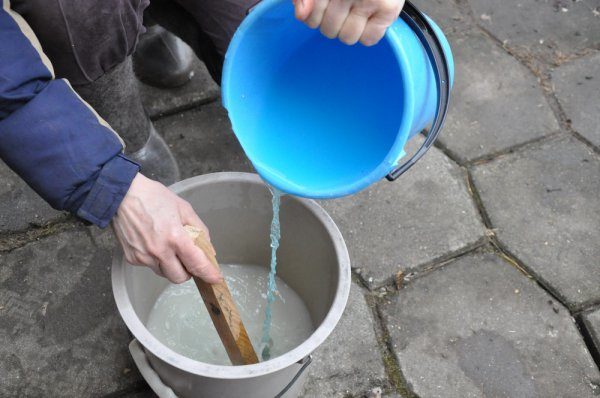
To prepare the drug for irrigation should be in the following proportions:
- 10 grams per 10 liters of water - for seedlings and indoor plants;
- 15-20 grams per 10 liters - for vegetable crops that are grown in open ground;
- 30 grams per 10 liters - for all fruit and berry plants.
Terms and methods of spraying plants
Spraying gardening culture, too, can and should be. This is best done in the evening at sunset or in the morning before dawn. During the day, it can quickly evaporate in the sun.
Optimally, plants should be sprayed before a wet visual film appears on the leaves. Do not allow the occurrence of rolling drops.
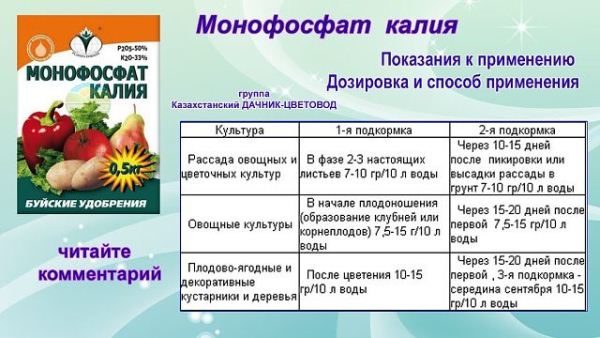
According to experts, it is quite enough to use potassium monophosphate two or three times a year:
- When seedlings of vegetable and flower crops:
- the first top dressing is in the phase of 2-3 true leaves;
- the second - 2 weeks after landing in the ground.
- For vegetable crops:
- the first - at the beginning of fruiting, the formation of tubers, root crops;
- the second - 2 weeks after the first feeding.
- For fruit and ornamental plants:
- the first - after flowering;
- the second - 2 weeks after the first;
- the third is in the middle of September.
Security measures when working with the tool
You can work with it only with gloves. Invalid ingress of mineral matter on the skin and mucous membranes. When spraying it is better to use a respirator.
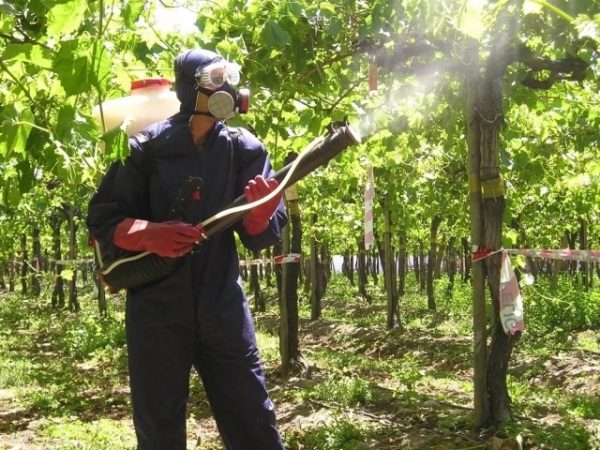
After work, you should immediately wash your hands and face with antibacterial soap.
Compatibility with other drugs
Potassium monophosphate is absolutely incompatible with drugs that have calcium and magnesium.
Combined use with nitrogen-containing fertilizers is not contraindicated. But it is better to apply nitrogen after monophosphate, in 2-5 days.
It combines well with other fertilizers.
First aid for poisoning
There are situations when spray solution gets into the eyes or on the skin. In such cases, as soon as possible, wash the affected areas with running water.
If the fertilizer gets into the stomach, it is necessary to immediately wash it. To do this, drink two glasses of water. After that, induce vomiting.
Storage conditions and shelf life
Fertilizer should be kept in a sealed bag in a ventilated room or outdoors,but away from light and water. It absorbs moisture well, and its subsequent use will be extremely inconvenient.
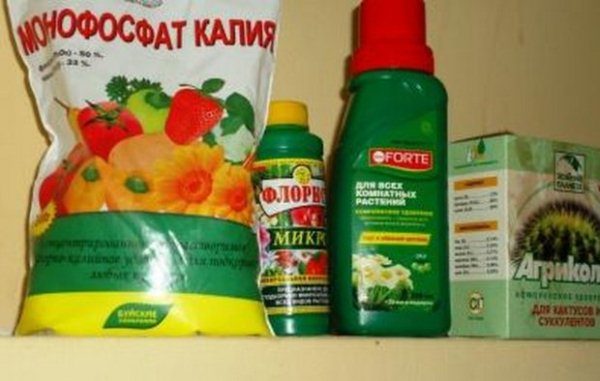
Shelf life is not limited.
In fact, potassium monophosphate is an ideal choice for fertilizing garden crops. He has many positive qualities that outweigh minor negative aspects. Minerals have a beneficial effect on the soil, nourish the plants, help them to grow steadily and abundantly bear fruit. Fertilizer can be purchased in small bags and large bags.
